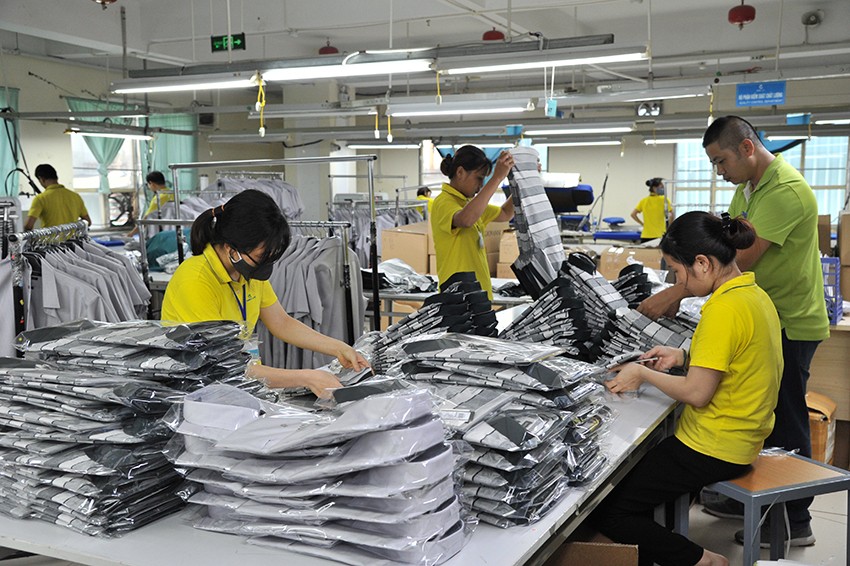 News
News
Mr. Vuong Duc Anh - Chief of Office of Vietnam National Textile and Garment Group said: In 2021, Vietnam's textile and garment ranked third in terms of exports in the world market with 5.7% market share. In 2022, Vietnam's textile and garment exports will reach 44.5 billion USD, up 10.5-11% compared to 2021, still ranked 3rd after China and Bangladesh.
Taking the US market as an example, leaders of Vietnam Textile and Garment Group explained why in difficult times, Vietnam's textile and garment industry still grew in numbers and maintained its position. Accordingly, the US partner assessed that Vietnam's textile and garment industry has a variety of product lines, difficult orders, and stable delivery times.
“ There are factories with 600 workers that can simultaneously produce 12 different product codes, in principle, management is extremely difficult. Normally, with such a space and labor, only 2-3 product codes can be made. These are the plus points that make Vietnam the first choice to order, ” said Mr. Le Tien Truong - Chairman of the Board of Directors of Vietnam Textile and Garment Group. At the same time, he said that small orders will be the trend in the coming time due to difficult consumption, importers will only place small orders of about 1,000-2,000 products.
 |
| In 2022, Vietnam's textile and garment industry will maintain the 3rd position in terms of exports in the world textile market |
With the EU market, Vietnam enjoys preferential treatment from the EU-Vietnam Free Trade Agreement. In 2022, the number of goods that meet the rules of origin and enjoy preferential treatment will be about 5-6%. This is also the driving force for buyers to come to Vietnam.
From the lessons of the past year, Mr. Le Tien Truong affirmed that it is impossible to accurately predict the situation of the world textile market for the whole year of 2023, but still can see a few points, corresponding to 3 scenarios. : World economic recession, demand reduced by 15% compared to 2022; the economic decline is not too severe, the demand decreases by 8-10%; In the event that the first half of 2023 the economy declines and then recovers, demand will decrease by 5-6% and orders will be abundant again.
Regarding the response to market scenarios, leaders of the Vietnam National Textile and Garment Group said that 13,000 textile and garment enterprises will have different responses. Particularly for Vinatex, it has been effectively implementing 5 goals: Consistently participating in the global supply chain; building a complete supply chain for the group to become a destination to supply from yarn to final garment for partners.
“ The trend of the world today is that customers want to contact partners who can do it from start to finish and cut out the middlemen. If there is a complete production system, the group will take an important step forward in the global supply chain ,” said Mr. Le Tien Truong.
The Group also steadfastly implements its commitments on social responsibility and green production as these will be non-financial factors to choose more sustainable partners to meet the new requirements of the market; digital transformation and automation; develop human and human resources to meet the requirements of green production, digital economy and digital transactions.
“ This will also be the 5 cross-cutting solutions of Vietnam National Textile and Garment Group for member units to cope with market fluctuations and implement the long-term plan set out ,” said Mr. Le Tien Truong. speak.
In 2023, according to Mr. Le Tien Truong, the most difficult thing is not being able to see the end of the market decline. At least for another 6-9 months, the market will be in a quiet state. Maybe for the first time in the world textile market there is a waveform demand. That is, maybe in June there will be a wave of consumption, orders will rush in 2-3 months and then drop again. In the long-term, the textile and garment market may not have a good signal, but catching the wave of businesses can be effective," said Mr. Le Tien Truong.
Textile and garment is a major export industry, accounting for about 80% of the output, depending on the world textile market is indisputable. However, how to overcome the crisis without suffering too much damage is a matter of concern. According to experts, the development of a supply of raw materials, having a foothold in the global supply chain is a necessary condition.
In the Strategy for the development of the textile and footwear industry to 2030, the vision to 2035, approved by the Government, also provides basic orientations for the industry. In which, the industry is oriented to develop towards specialization and modernization; accelerate the shift from manufacturing outsourcing to forms requiring higher capacity.
Developing fashion and textiles, promoting and creating cohesion, coordination between manufacturers, product design and development and sales to orient and create fashion trends for the domestic market; develop product branding and national brand. Developing a fashion center in Ho Chi Minh City. Ho Chi Minh City and Hanoi Capital.
Along with that, the orientation to promote investment in the production of raw materials, auxiliary materials, supporting industries for the textile, garment and footwear industries; focusing on the production of fabrics, artificial fabrics, leather, encouraging the production of fabrics from domestically produced yarns in order to reduce imports, positively impact the linkages, form a complete supply and value chain in the region. branch…
It is expected that with a clear development orientation, relevant agencies will develop policies that are strong enough and attractive to investors to develop a strong, strong and sustainable textile and garment industry, achieving the goal of becoming a key industry. export. At the same time, create a competitive advantage, step by step to a higher position on the world textile map.